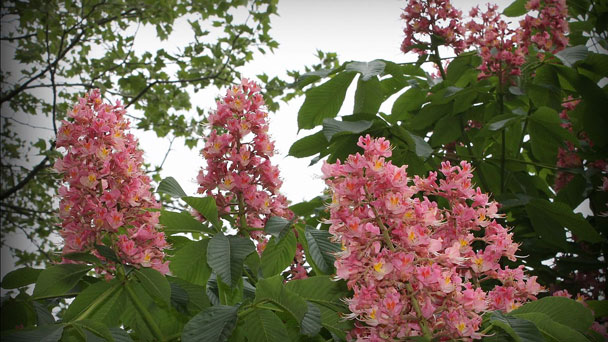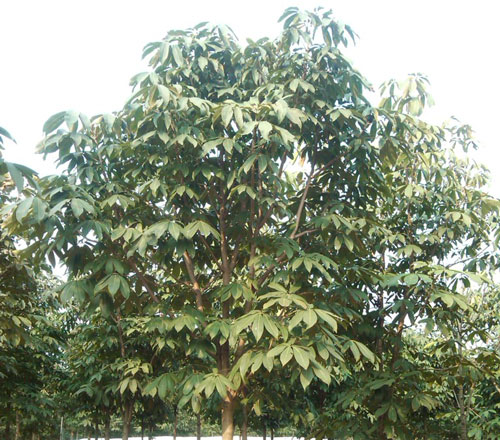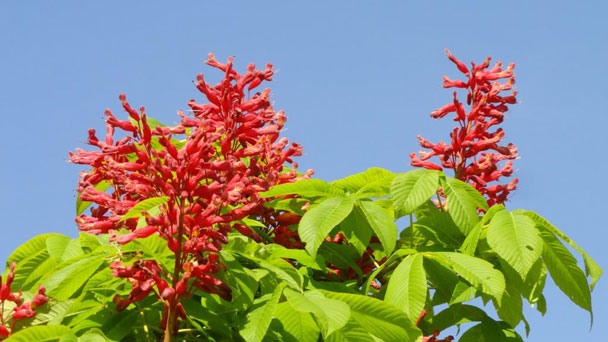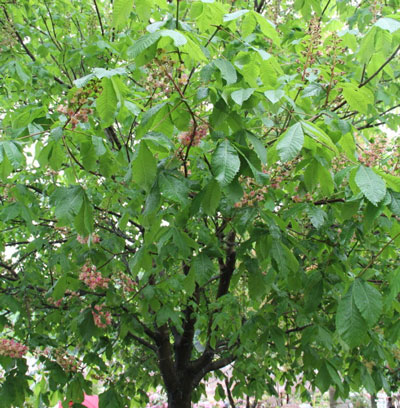Red Buckeye Tree: How to Grow & Care for Aesculus Pavia
Written by Iris
Nov 05 2021

Red Buckeye Tree (Aesculus Pavia) is a small tree native to North America, growing to 25 to 30 feet tall in the wild, but usually reaching 15 to 20 feet tall in cultivation. Red Buckeye Tree (Aesculus Pavia) is most popular for its spring display of three - to six-inch-long, erect panicles, which are composed of red flowers 1.5 inches wide and very attractive to hummingbirds. These flowers of Red Buckeye Tree (Aesculus Pavia) are followed by flat round capsules containing bitter and poisonous seeds. The large, dark green palmate leaves usually do not show much color change in the fall and usually drop as early as late September. The next will introduce how to grow and care for Red Buckeye Tree.

Clean potting mixes, such as those made with equal portions of perlite and peat moss, help prevent Red Buckeye Tree disease and provide good drainage for seedling development. Soak a 4-inch pot in a solution of 1 part household bleach and 9 parts water for 5 minutes. Rinse the POTS and fill them with potting mixture to within 1/2 inch of the top of the pot. Use flowerpots with drainage holes. Soak the Red Buckeye Tree seeds in water for 24 hours before planting them in a pot. After soaking, remove the seeds from the water and place them in a 5% solution of bleach. Remove the seeds from the bleach after a minute, then rinse with water. Bleach helps kill any fungi that may be present on the seeds, preventing them from germinating properly. Place one seed in each pot, radicle side down. The hole should be a little wider than the seed and twice as deep as the seed. After covering the Red Buckeye Tree seeds with the potting mixture, water the pot until the water runs out of the drain. The pot needs bright light until the seedlings appear. Keep the potting mixture moist.
Red Buckeye Tree seeds usually germinate within 21 days after sowing, and the survival rate after transplanting is about 90%. Once the seedlings have several sets of true leaves, check to make sure they are not bound by the roots. When the roots hold the potting mixture together but haven't yet started winding around the bottom of the pot, transplant them into a 1-gallon container, using the same potting mixture. After placing them in larger POTS, gradually move them to stronger light, adding an hour or two each day until they are in full sunlight. Keep the potting mixture moist. (Find more fall plants here.)
Don't worry too much about pests. Red Buckeye Trees are native trees and are virtually pest and disease-free. However, they can be hit by a disease called leaf blotch. It doesn't kill the red buckeye tree, but the leaves will look scorched and fall early.
Texas Buckeye Tree: The Texas buckeye has large glossy green lanceolate leaflets with serrated edges make up the tree’s palmate leaves.
Red Buckeye Tree: The red buckeye tree is one of the most spectacular ornamental deciduous trees, thanks to its vibrant red flowers. The red buckeye is a small landscape tree that has an oval crown, glossy dark green leaves, and red spring flowers. The red buckeye leaves are lance-shaped, and five leaflets make up the compound leaves.
Dwarf Red Buckeye Tree: Pink or red flowers, only grows to 20 feet
Yellow Buckeye Tree: Yellow or yellow-green flowers, reaches heights of 35 feet
Read Next:
Top 30 Fall Flowers to Plant - Beautiful Autumn Flowers
30 Fall Plants for a Beautiful Fall Garden
Where to Grow Red Buckeye TreeHow to Grow Red Buckeye Tree (Aesculus Pavia)Grow a Red Buckeye Tree from SeedPlant a Red Buckeye Tree from CuttingsHow to Grow & Care for Red Buckeye Tree (Aesculus Pavia) Red Buckeye Tree Light CareRed Buckeye Tree Soil CareRed Buckeye Tree Water CareRed Buckeye Tree Temperature & Humidity CareRed Buckeye Tree Fertilizer CareRed Buckeye Tree PruningRed Buckeye Tree Pests & DiseasesVarieties of Buckeye TreesRed Buckeye Tree (Aesculus Pavia) FAQAre Red Buckeye Trees messy?Are Red Buckeye Trees poisonous?
Where to Grow Red Buckeye Tree
In a domestic landscape, the Red Buckeye Tree prefers to be planted in well-drained, loamy soil rich in organic matter. Amend your soil with an organic mix, and, if necessary, add a little lime if your soil is acidic. Although it is a denizen of the shady deciduous forest, red buckeye tree will bloom more prolifically if you plant it in an area with full sun. But if you're in a warmer climate, make sure you protect it from the hot afternoon sun in summer. Once established, red buckeye Tree is tolerant of both occasional drought and flooding.
How to Grow Red Buckeye Tree (Aesculus Pavia)
Grow a Red Buckeye Tree from Seed
Red buckeye tree seeds resemble chestnuts, with glossy brown seeds contained in a shell that is first green and then brown. Fresh Red buckeye tree seeds are best and can be planted immediately after harvest, although properly stored, undried and refrigerated seeds will also germinate. In autumn, Red Buckeye Tree seeds are collected immediately after maturity. Stored seeds need to be treated cold, called stratification, before germinating. For the damp cold you need, place wet sand or wet new perlite in resealable plastic bags, remove the shells and add the Red Buckeye Tree seeds so they are covered with the damp material, then place the bags in the fridge for three to eight weeks. After three weeks, check the seeds weekly to remove the seeds that give off the seed roots, called radicles, so you can pot them.Clean potting mixes, such as those made with equal portions of perlite and peat moss, help prevent Red Buckeye Tree disease and provide good drainage for seedling development. Soak a 4-inch pot in a solution of 1 part household bleach and 9 parts water for 5 minutes. Rinse the POTS and fill them with potting mixture to within 1/2 inch of the top of the pot. Use flowerpots with drainage holes. Soak the Red Buckeye Tree seeds in water for 24 hours before planting them in a pot. After soaking, remove the seeds from the water and place them in a 5% solution of bleach. Remove the seeds from the bleach after a minute, then rinse with water. Bleach helps kill any fungi that may be present on the seeds, preventing them from germinating properly. Place one seed in each pot, radicle side down. The hole should be a little wider than the seed and twice as deep as the seed. After covering the Red Buckeye Tree seeds with the potting mixture, water the pot until the water runs out of the drain. The pot needs bright light until the seedlings appear. Keep the potting mixture moist.
Red Buckeye Tree seeds usually germinate within 21 days after sowing, and the survival rate after transplanting is about 90%. Once the seedlings have several sets of true leaves, check to make sure they are not bound by the roots. When the roots hold the potting mixture together but haven't yet started winding around the bottom of the pot, transplant them into a 1-gallon container, using the same potting mixture. After placing them in larger POTS, gradually move them to stronger light, adding an hour or two each day until they are in full sunlight. Keep the potting mixture moist. (Find more fall plants here.)
Plant a Red Buckeye Tree from Cuttings
The Red Buckeye Tree can also be grown from root cuttings. These are taken in the winter just prior to the onset of spring growth. Stem cuttings are another alternative propagation method of Red Buckeye Tree. These require a very humid environment for success. As with seed propagation, the plants started by these methods will devote their energy in the first couple of growing seasons to the development of a strong root system. Little will be visible in the form of stems or leaves.
How to Grow & Care for Red Buckeye Tree (Aesculus Pavia)
Red Buckeye Tree Light Care
Red Buckeye Tree will thrive in full sun, with at least four to six hours of daily direct, unfiltered sunlight. It can also tolerate partial sun/shade. They are prone to burns in the high temperature from July to August, especially during the nursery year. Timely shade can not only reduce the burning chance but also promote the growth of seedlings. In the seedling year, the shading net with 50% light transmittance should be used from mid to late May to early September, and the sun should be shaded from late June to late August in the second year. Through shading, the Red Buckeye Tree seedling height in the first and second year of seedling raising was 20.4% and 16.0% higher than that of the unshaded Red Buckeye Tree.Red Buckeye Tree Soil Care
Tolerant to an array of soils, the Red Buckeye Tree will grow in acidic soils. It can also tolerate alkaline and clay soils. The soil should always be kept moist and well-drained to promote optimal growth.Red Buckeye Tree Water Care
The Red Buckeye Tree should be watered regularly to maintain wet or evenly moist soil. Be sure to water at least weekly. It can, however, tolerate occasional drought as well as occasional flooding.Red Buckeye Tree Temperature & Humidity Care
The Red Buckeye Tree will bloom in in late spring. As a deciduous tree, it will lose its leaves seasonally.Red Buckeye Tree Fertilizer Care
Buckeye trees respond well to a liquid fertilizer when it's planted, or later when Red Buckeye Tree seeds sprout. Be sure to maintain a monthly feeding schedule for the first two years, and then once the roots are well established you can use fertilizer once every six months. No fertilizer is needed once the tree is four or five years old.Red Buckeye Tree Pruning
No pruning is needed but gives red buckeye trees some space—great for privacy hedge and property border.Red Buckeye Tree Pests & Diseases
Red Buckeye Tree seeds are very attractive to squirrels. If you're planting red buckeye tree from seeds, plant two seeds for every tree you hope to grow.Don't worry too much about pests. Red Buckeye Trees are native trees and are virtually pest and disease-free. However, they can be hit by a disease called leaf blotch. It doesn't kill the red buckeye tree, but the leaves will look scorched and fall early.
Varieties of Buckeye Trees
Ohio Buckeye Tree: The Ohio buckeye is a popular ornamental flowering tree with a rounded crown and dense, dark green leafy foliage. You can identify this tree in spring by the conical clusters of yellowish-green flowers.Texas Buckeye Tree: The Texas buckeye has large glossy green lanceolate leaflets with serrated edges make up the tree’s palmate leaves.
Red Buckeye Tree: The red buckeye tree is one of the most spectacular ornamental deciduous trees, thanks to its vibrant red flowers. The red buckeye is a small landscape tree that has an oval crown, glossy dark green leaves, and red spring flowers. The red buckeye leaves are lance-shaped, and five leaflets make up the compound leaves.
Dwarf Red Buckeye Tree: Pink or red flowers, only grows to 20 feet
Yellow Buckeye Tree: Yellow or yellow-green flowers, reaches heights of 35 feet

Red Buckeye Tree (Aesculus Pavia) FAQ
Are Red Buckeye Trees messy?
It is somewhat messy and has limited ornamental value except the early spring flowering period. In fact, this tree tends to develop leaf scorch in hot, dry seasons and tends to drop foliage in late summer or early fall, earlier than other trees.Are Red Buckeye Trees poisonous?
Yes, Aesculus pavia (Red Buckeye Tree), is highly toxic. Eating the seeds or drinking tea made from leaves or sprouts can cause severe illness or even death. Cattle in a pasture with a Red Buckeye Tree often eat the seeds and become ill or even die.Read Next:
Top 30 Fall Flowers to Plant - Beautiful Autumn Flowers
30 Fall Plants for a Beautiful Fall Garden
Latest Updated
- Benefits of Bugleweed - 7 Science-backed Health Benefits
- Bugleweed Dangers & Side Effects - Is It Poisonous?
- How to Plant Evergreen Trees - What You Should Know
- When to Plant Evergreens - Grow Guide for Evergreen Trees
- 12 Wonderful Evergreen Shrubs for Your Garden
- 12 Popular Evergreen Plants with Pictures for Beginners
- When And How To Prune A Lilac Bush Like a Pro
- How to Grow & Care for Lilac Vine (Hardenbergia Violacea)
- Japanese Lilac Tree (Syringa Reticulata) Care & Propagation Guide
- Shumard Oak Pros and Cons - What to Know
Popular Articles
- Winter maintenance of Antirrhinum Majus
- How to Grow Terminalia Mantaly Tree
- How to Grow and Care for Crossostephium Chinense
- How to grow Antirrhinum Majus in spring
- Peristeria Elata (Dove Orchid) Profile: Info & Care Guide
- Underwatered Snake Plant (Sansevieria Trifasciata) - Signs And How To Fix
- How to Care for Brazilian Jasmine Plant (Mandevilla Sanderi)
- How to Grow & Care for Graptopetalum Purple Delight in Summer
- Rosa Chinensis (China Rose): Plant Growing & Care Tips
- How to Care for Baby Sun Rose (Aptenia Cordifolia)